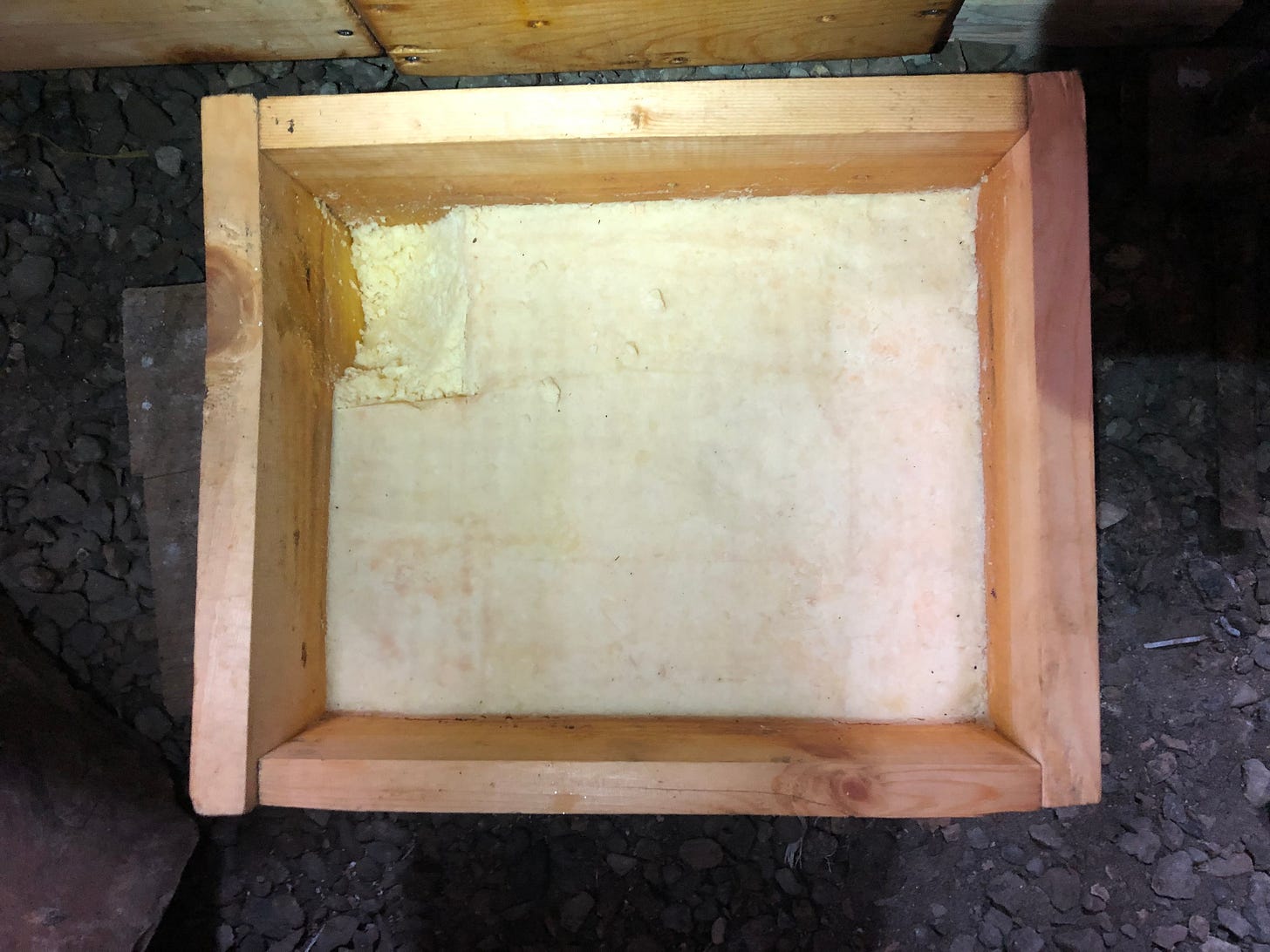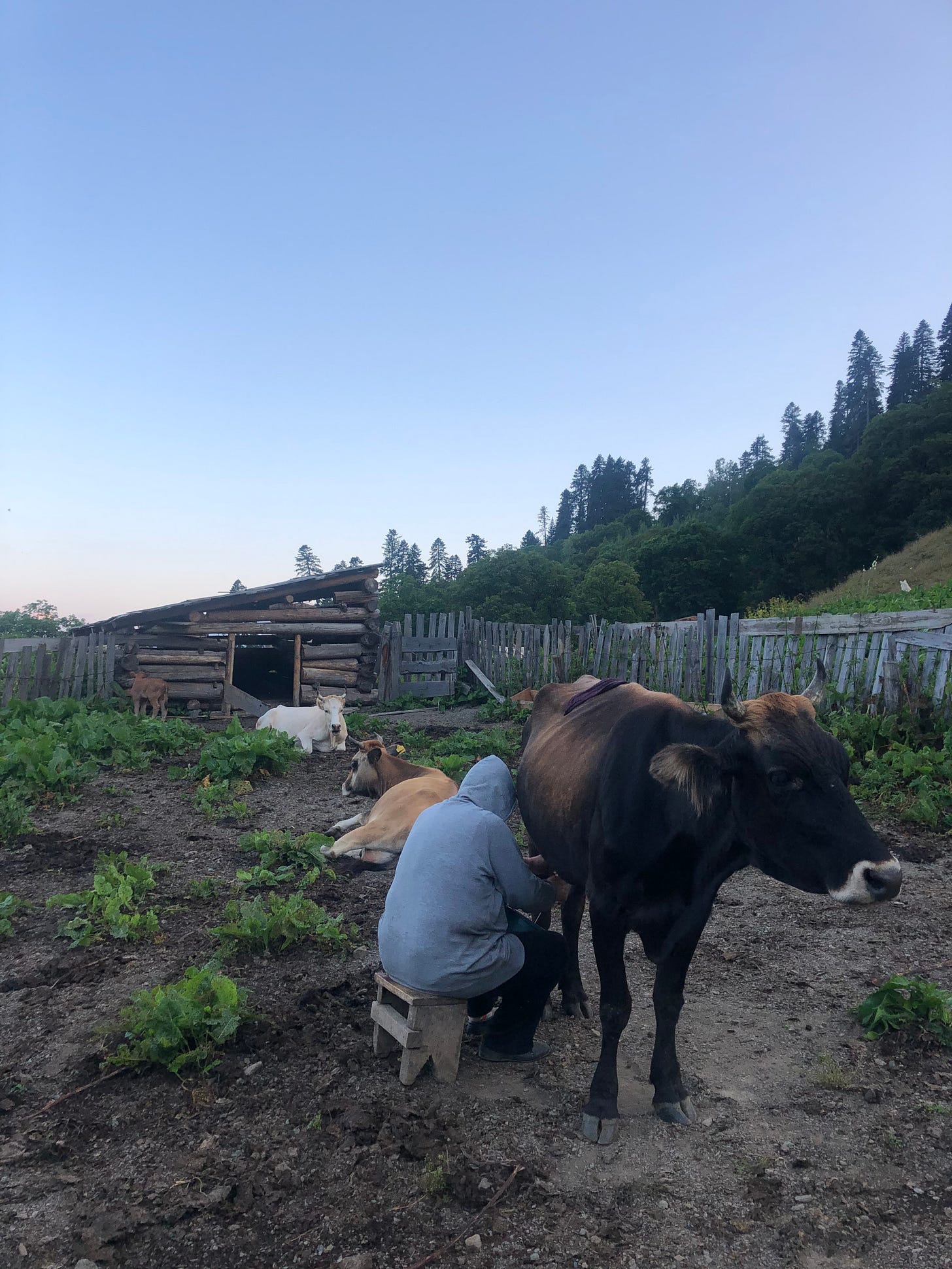I knew very little about Narchvi when I traveled for 2 days up into the Caucasus mountains of Svaneti. It is a large crumbly cheese aged in a wooden box. That was enough for me to be intrigued. I knew I had to meet Ira Ansiani and her family, who may be the only ones still making it. After a brief text message exchange with her daughter-in-law, I was on my way. Arriving at the family home, I met Zurabi, the family patriarch, who radiates a warm presence I was immediately comforted by. I was treated to a huge lunch and pitchers of homemade natural wine. This is customary Georgia hospitality, and I’ve learned that establishing rapport with pastoralists in this country generally requires getting drunk with them first.

As is often the case, I had no idea what the plan was for my stay. Buy the ticket, take the ride. I was pleasantly surprised to learn that the family practices transhumance and that I would be staying with Ira at a high elevation grazing area. It is a 1.5 hour drive up a rough 4x4 logging road to this area. Like an alpage in the Alps, it was situated near tree line, where forest gives way to subalpine meadows. Small wood houses served as homes for an extended family, along with pigs and guard dogs. The small off grid community seems to consists of Ira and Zurabi’s children, grandchildren, and in laws. The exact relationships were never clear to me. It’s always good to see the younger generations involved in the work of milking, making cheese, and herding livestock. This is the only way these things will keep going.
In America, and much of the world, cheeses tend to be made on one day, and salted the next. Each cheesemaking session leads to a single batch of cheese. The initial fermentation tends to be rapid, and this is rightly seen as a safety mechanism. The milk ferments predictably, with little space left for undesired microbes to get involved. But a trend in many of the cheeses I have been looking at is a slower fermentation, with 2-3 days elapsing before the cheese is made into its final shape and salted. I feel that this approach can lead to interesting expressions of milk and microbes that do not manifest when the process is rushed. This can be compared to baking sourdough, where a slower, toned down fermentation potentially leads to greater depth of flavor and nuance. There is more room for error, and for excellence. This doesn’t apply to all styles, some are marked by a rapid fermentation and low final ph, lactics in particular.
There exists an approach to making cheese that likely used to be more widespread, of which a few relics remain. These are cheeses made by mixing multiple days worth of curd, which have various levels of moisture and acidity. The curd produced over a few days is combined by milling, a process of breaking up or crumbling the curd by hand, or machine. Then a single large wheel is formed, pressed, and aged. The famous members of this class are Castelmagno made in Italy, and Kirkham’s Lancashire from the UK. I have the sense that some of the cheeses aged in skin sacks are also made in this way.
When I saw Kirkham’s made while in the UK, I was blown away. The cheese has the most pleasant multi-pronged texture, and develops flavor rapidly. A lot of this I feel has to do with the changes in 2 and 3 day old curd, and the contrast between them. The 3 day old curd has yeast coming in, and this is doing some sort of pre ripening, before the cheese is salted and shaped. Read the Substack entry I posted about this in January : Link
Narchvi pushes this logic to an extreme I have not seen or heard of. After both morning and evening milking, a single wheel is made from milk still udder warm. The wheels sit in a bowl and slowly ferment, and then are milled (broken into small pieces) through a meat grinder once a week. That means some of the wheels are 5, 6, or 7 days old. These wheels will have various levels of moisture and acidity. They smell yeasty, fruity, and sour.
The milled curd has funky aromas of durian, over ripe papaya, a hint of butyric acid, and what I can only describe as rot. If I didn’t know it was intentionally done, I never would have tasted it, it smells unsafe. But taste it I did, and it was very yeasty, but not unpleasant. The milled curd has an appearance that I associate with yeast, it has an off color and has lost the wet shine of fresh curd. There is serious enzymatic action and breakdown happening here, as the curd has sat unsalted for up to a week. Iras milking procedure is clean, she wipes teats down by hand, then with a rag. She cleans her milk pails in nearly boiling water after every milking.

The day after being milled, the huge pot of curd, a weeks worth of cheese, is mixed and mashed by hand with salt. It becomes somewhat like grains and chunks inside a paste. This is packed into a woven plastic sack, and allowed to drain under weight before being packed tightly in the wooden box and pressed with a lot of weight. It ages in a side room with a loose rock gravel floor, that is at ambient temperature, but stays slightly cooler than outside.







